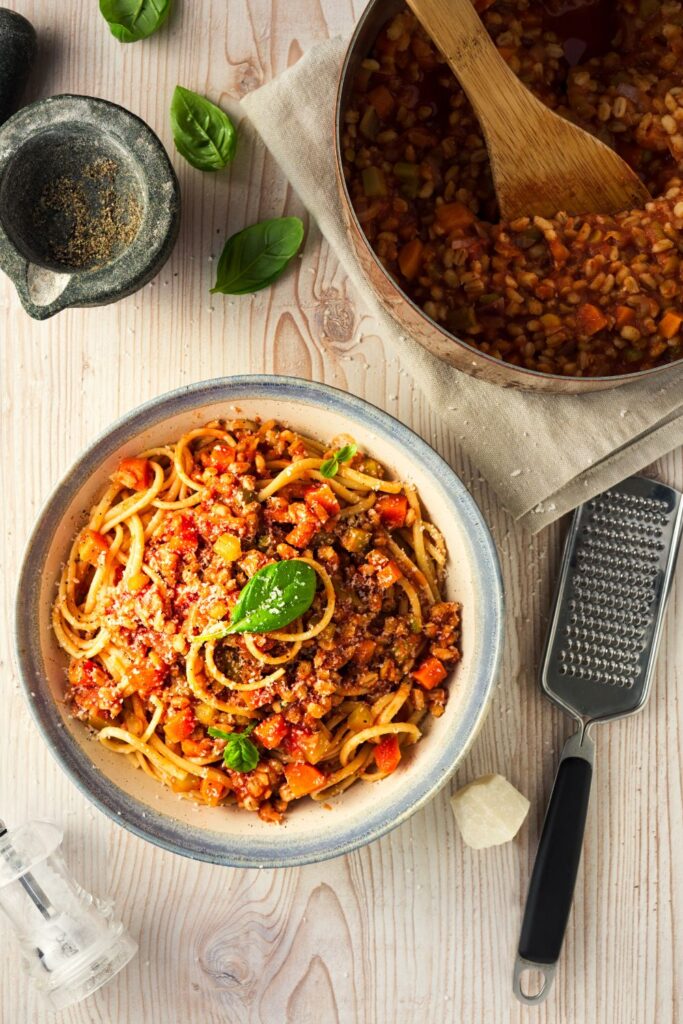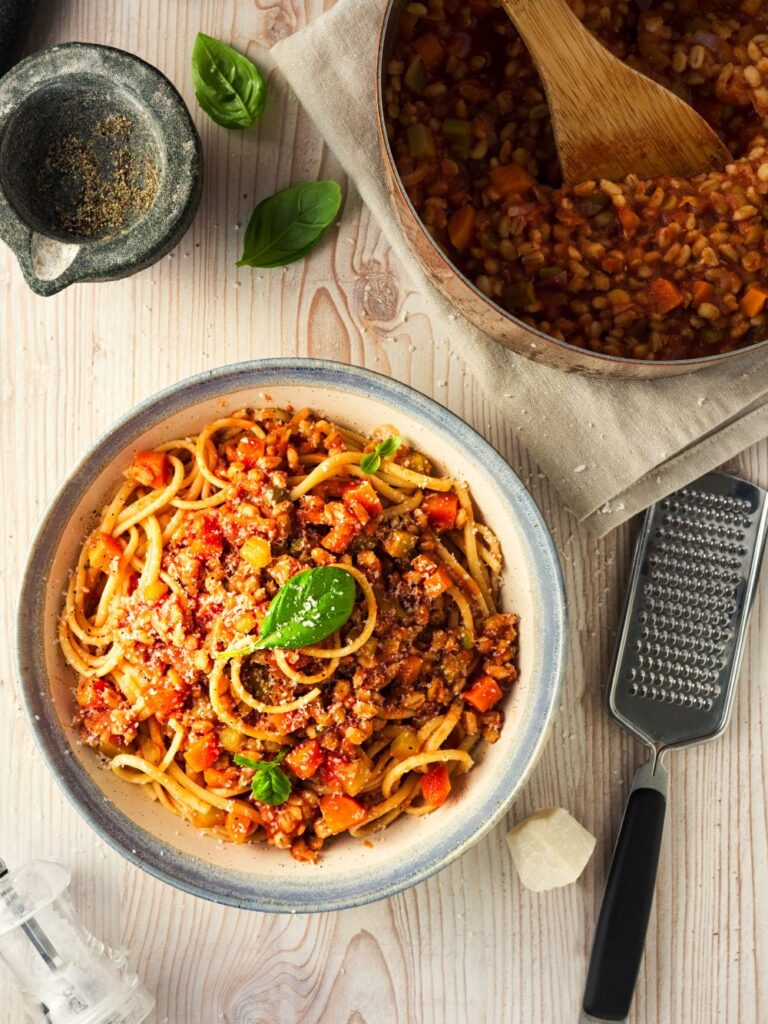There’s a rhythm to making a proper Bolognese — the chopping, the slow stir of garlic hitting butter, the smell of red wine melting into tomato. I make this when I need the day to slow down a bit. It’s not a “throw it together in ten” kind of meal. It’s a let-it-simmer, glass-of-wine-in-hand, socks-on-the-radiator kind of dish.
I still remember the first time I properly nailed it — used stewing steak instead of regular mince, gave it hours, not minutes, and actually let it sit before serving. Changed everything. Suddenly, it wasn’t just dinner. It was something. Cozy, rich, layered. Like a big warm jumper in food form.
So here’s my version, leaning on James Martin’s bones, but with the honesty and slowness this sauce deserves.
Why You’ll Love It
- Deep, slow flavour. Stewing steak gives this dish so much more depth than quick-cook mince.
- Freezes like a dream. Make double and stash some away.
- Proper comfort food. The kind you eat in socks, not shoes.
- Simple ingredients, big results. It’s just technique and patience.
- Flexible. Use pecorino, parmesan, even cheddar in a pinch. It’ll still work.
- Feels like a hug in a bowl. No fancy plating required.
Ingredients
- 300g fresh spaghetti (or dried, no drama)
For the sauce:
- 50ml olive oil
- 50g butter
- 1 onion, finely chopped
- 1 stick celery, diced
- 1 carrot, diced
- 1kg beef stewing steak, minced or finely chopped
- 3 cloves garlic, diced
- 2 sprigs fresh thyme
- Small bunch fresh basil, chopped
- 500g passata
- 100ml beef stock
- 1 glass red wine (about 150ml — and yes, use something drinkable)
- 3 tbsp tomato purée
To serve:
- Grated parmesan or pecorino
- Extra fresh basil, if you fancy
How to Make It
Sauté the base veggies:
Heat the olive oil and butter in a large pot over medium heat. Add the onion, celery, and carrot. Cook gently for about 10 minutes until soft, sweet-smelling, and just starting to colour. I always forget the pancetta at this stage — feel free to throw some in if you’ve got it.
Brown the beef like you mean it:
Add the beef in batches if needed, breaking it up as you go. You want some proper browning here — colour = flavour. Don’t rush this bit, even if the dog’s giving you that “dinner now” look.
Layer in the flavour:
Stir in the garlic, thyme, and basil. Let them bloom in the heat for a minute, just until fragrant. Then stir in the tomato purée and cook it out for another minute. This takes off that tinny taste.
Wine, stock, and passata go in:
Pour in the red wine and let it bubble for a minute or two, scraping the bottom of the pan as you go. Add the passata and beef stock, stir, and bring it all to a gentle simmer.
Let it do its thing:
Turn the heat to low, pop a lid on (slightly ajar), and let it cook slowly for 2 to 3 hours. Stir it now and then, have a taste, and feel smug. The house will start to smell incredible — it always does.
Get the spaghetti sorted:
When the sauce is nearly done, cook your spaghetti according to the packet. Salt the water like the sea — it matters.
Serve it up proper:
Drain the pasta, toss it with a ladle or two of the sauce, then pile it into bowls. Spoon more sauce on top, grate over a little cheese, and finish with a torn basil leaf if you’re feeling extra.

Common Mistakes and How to Dodge Them
Why’s my sauce watery?
You probably didn’t simmer it long enough. Let it go low and slow — at least two hours. Lid off near the end helps reduce it too.
Why does it taste flat?
It’s usually salt or acidity. Add a pinch more salt or a dash of red wine vinegar at the end if it needs a lift.
Can I use mince instead of stewing steak?
Of course! But give it time and don’t skip the browning — it still needs love.
Do I really need wine?
If you’ve got it, yes. It adds depth. If not, a splash of balsamic or a spoon of Worcestershire sauce can give some of that same complexity.
Storage and Reheating
Fridge: Store the sauce (and pasta separately if you can) in airtight containers for up to 4 days.
Freezer: Freeze the sauce in batches. Reheat straight from frozen on the hob or defrost overnight.
Reheat like this:
- Stovetop: Heat gently, adding a splash of water or stock if it thickens too much.
- Microwave: Cover and microwave in bursts, stirring in between.
- Don’t reboil the pasta. It goes mushy — better to cook fresh spaghetti if you can.
Frequently Asked Questions
Can I add milk like some recipes suggest?
Sure can. A splash of milk near the end mellows the acidity and makes it velvety. Totally optional though.
Can I make this vegetarian?
You’d have to switch to lentils or mushrooms. It won’t be traditional Bolognese, but it’ll still be lovely.
What’s the best wine to use?
Something dry and red. Nothing fancy — just avoid anything super sweet.
How long can I simmer it for?
Up to 4 hours if you’ve got time. The longer it goes, the better it gets.
Nutrition Facts (Per Serving):
- Calories: 667 kcal
- Total Fat: 22g
- Saturated Fat: 6.5g
- Trans Fat: 0.5g
- Cholesterol: 62mg
- Sodium: 637mg
- Potassium: 1134.6mg
- Carbohydrates: 84g
- Dietary Fiber: 11g
- Sugars: 14g
- Protein: 35g
Try More James Martin Recipes:

James Martin Spaghetti Bolognese
Description
A rich, slow-cooked Bolognese made with beef steak, fresh herbs, and red wine — the ultimate comfort food, piled high over hot spaghetti.
Ingredients
Instructions
- Cook onion, celery, and carrot in oil and butter.
- Add beef, brown well.
- Stir in garlic, thyme, basil, and tomato purée.
- Add passata, stock, and wine. Simmer 2–3 hours.
- Cook pasta and toss with sauce.
- Serve topped with cheese and basil.
Notes
- Simmer uncovered near the end if the sauce feels too wet.
- Freeze extra sauce for quick weeknight meals.
- Fresh basil at the end really lifts the flavour.
- Don’t overcook the pasta — it should still have bite

